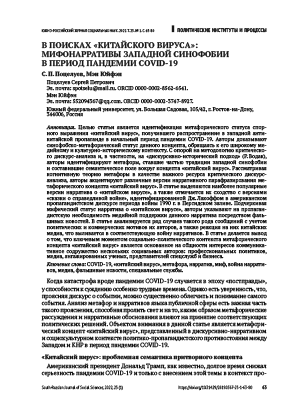Abstract
The object of this article is to identify the metaphorical status of the controversial disputable expression the “Chinese virus”, which became widespread in Western anti-China propaganda during the initial period of the COVID‑19 pandemic. The authors prove the sinophobic and metaphorical status the concept, referring to broad multimedia and socio-cultural and historical background of its context. Using the methodology of critical discourse analysis and, in particular, the “discourse-historical approach” (R. Vodak), the authors identify the metaphors that have become part of the Western Sinophobia tradition that constitute the semantic field around the concept of the “Chinese virus”. Considering the cognitive theory of metaphor as an important resource for critical discourse analysis, the authors accentuate the different versions of narrative paraphrasing of the metaphorical concept of the “Chinese virus”. The article highlights the most popular versions of the “Chinese virus” narrative and notes their similarities to the versions of the “just war fairy tale” identified by J. Lakoff in American propaganda discourse during the 1990s Persian Gulf War. While emphasizing the mythical status of the “Chinese virus” narrative, the authors point to the propaganda urgency to support this narrative through fake news. The article analyzes a number of cases of such messages, focusing on the political and commercial motives of their authors, as well as the response of the Chinese media to them, which results in the corresponding war of narratives. The study concludes that the key element of the sociopolitical context of the metaphorical concept of the “Chinese virus” is the communicative commonwealth of several social actors based on common interests: professional politicians, the media, the engaged scientists, and representatives of intelligence services and businesses.
Keywords
References
Анкерсмит, Ф. (2003). Нарративная логика: Семантический анализ языка историков. М.: Идея-Пресс.
Аматов, А.М., Бондаренко, Е.В., Пупынина, Е.В. (2019). Американский политический дискурс: метафоры войны и война метафор. Научные ведомости. Серия: Гуманитарные науки, 38(1), 5–12.
Дейк Т., ван (2013). Дискурс и власть: репрезентации доминирования в языке и коммуникации. Москва: Книжный дом «ЛИБРОКОМ».
Лакофф, Дж., Джонсон, М. (2004). Метафоры, которыми мы живем. Москва: Едиториал УРСС.
Скрынникова, И.В. (2017). Метафорический фрейминг политических событий: как формируются убеждения? В Всероссийская конференция по когнитивной науке КИСЭ‑2017 (c. 267–277). Казань: Изд-во КФУ.
Alexander, R.J. (2013). Shaping and Misrepresenting Public Perceptions of Ecological Catastrophes: the BP Gulf Oil Spill. Critical Approaches to Discourse Analysis across Disciplines, 7, 1–18.
Brugman, B.C., Burgers, C., Vis, B. (2019). Metaphorical Framing in Political Discourse through Words vs. Concepts: A Meta-Aanalysis. Language and Cognition, 11(1), 41–65.
Fairclough, N. (1995). Critical Discourse Analysis: Papers in the Critical Study of Language. New York: Longman.
Fuchs, C. (2020). Everyday Life and Everyday Communication in Coronavirus Capitalism. TripleC, 18(1), 375–399.
Gamson, W.A., Modigliani, A. (1989). Media Discourse and Public Opinion on Nuclear Power: A Constructionist Approach. American Journal of Sociology, 95(1), 1–37.
Jacob, J.T. (2020). ‘To Tell China’s Story Well’: China’s International Messaging during the COVID‑19 Pandemic. China Report, 56(3), 374–392.
Lakoff, G. (1999). Metaphorical Thought in Foreign Policy. Why Strategic Framing Matters. Berkeley: The University of California at Berkeley and The Rockridge Institute.
Lynteris, C. (2018). Plague Masks: The Visual Emergence of Anti-Epidemic Personal Protection Equipment. Medical Anthropology Journal, 37(6), 442–457.
Lynteris, C. (2018). Yellow Peril Epidemics: The Political Ontology of Degeneration and Emergence. In F. Bille, S. Urbansky (Eds) Yellow Perils: China Narratives in the Contemporary World (pр. 34–53). Honolulu: University of Hawaii Press.
Menon, R. (2003). The Sick Man of Asia: Russia’s Endangered Far East. The National Interest, 73, 93–105.
Odijie, M. (2018). The Fear of ‘Yellow Peril’ and the Emergence of European Federalist Movement. The International History Review, 40(2), 358–375.
Panther, K.—U. (2006). Metonymy as a Usage Event. In G. Kristiansen, M. Achard, R. Dirven, F.J.R. de Mendoza Ibáñez (Eds) Cognitive Linguistics: Current Applications and Future Perspectives (pp. 147–186). Berlin: Mouton de Gruyter.
Rasmussen, A.L. (2021). On the Origins of SARS-CoV‑2. Nature Medicine, 27(9), 8–9.
Schön, D.A. (1979). Generative Metaphor: A Perspective on Problem-setting in Social Policy. In A. Ortony (Ed.) Metaphor and Thought (pp. 254–283). Cambridge: Cambridge University Press.
Sontag, S. (1978). Illness as Metaphor. New York: Farrar, Straus and Giroux,
Wodak, R. (2015). Critical Discourse Analysis, Discourse-Historical Approach. In K. Tracy, C. Ilie and T. Sandel (Eds) The International Encyclopedia of Language and Social Interaction (pp. 1–14). Boston: John Wiley & Sons.
Zhang, D. (2021). Sinophobic Epidemics in America: Historical Discontinuity in Disease Related Yellow Peril Imaginaries of the Past and Present. Journal of Medical Humanities, 42, 63–80.


